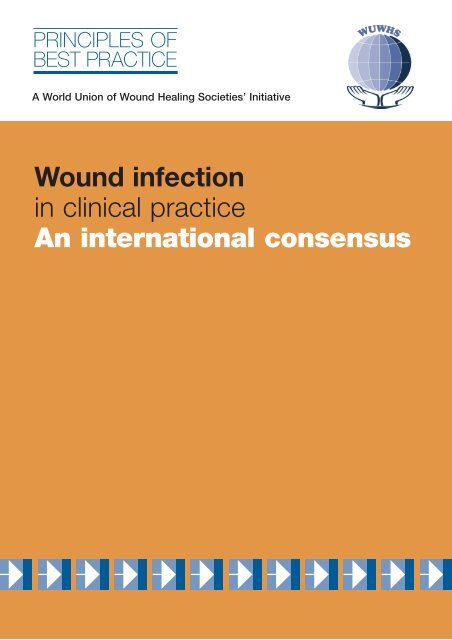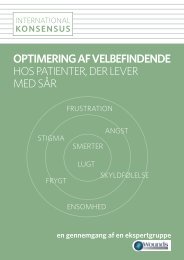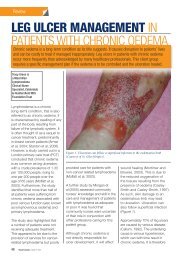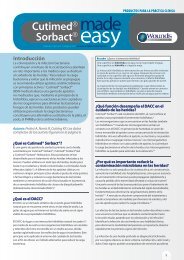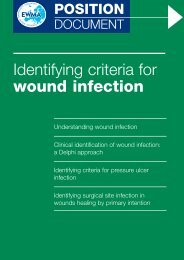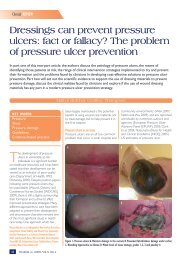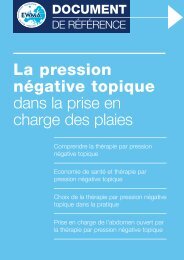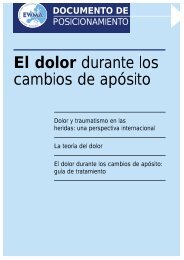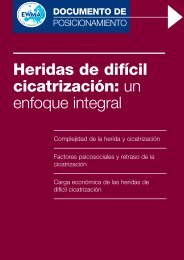Wound infection in clinical practice: an international consensus
Wound infection in clinical practice: an international consensus
Wound infection in clinical practice: an international consensus
Create successful ePaper yourself
Turn your PDF publications into a flip-book with our unique Google optimized e-Paper software.
PRINCIPLES OFBEST PRACTICEA World Union of <strong>Wound</strong> Heal<strong>in</strong>g Societies’ Initiative<strong>Wound</strong> <strong><strong>in</strong>fection</strong><strong>in</strong> cl<strong>in</strong>ical <strong>practice</strong>An <strong>in</strong>ternational <strong>consensus</strong>
MANAGING EDITOR:Lisa MacGregorHEAD OF WOUND CARE:Suzie CalneEDITORIAL PROJECTMANAGER:Kathy DayMANAGING DIRECTOR:J<strong>an</strong>e JonesPRODUCTION:Alison PughDESIGNER:J<strong>an</strong>e WalkerPRINTED BY:Pr<strong>in</strong>twells, Kent, UKFOREIGNTRANSLATIONS:RWS Group, London, UKPUBLISHED BY:Medical EducationPartnership (MEP) LtdOmnibus House39–41 North RoadLondon N7 9DP, UKTel: + 44 (0)20 7715 0390Fax: +44 (0)20 7715 0391Email: <strong>in</strong>fo@mepltd.co.ukWeb: www.mepltd.co.ukFOREWORD<strong>Wound</strong> <strong><strong>in</strong>fection</strong> cont<strong>in</strong>ues to be a challeng<strong>in</strong>g problem <strong>an</strong>d represents a considerablehealthcare burden. Early recognition along with prompt, appropriate <strong>an</strong>d effective<strong>in</strong>tervention are more import<strong>an</strong>t th<strong>an</strong> ever <strong>in</strong> reduc<strong>in</strong>g its economic <strong>an</strong>d healthconsequences, especially <strong>in</strong> the context of grow<strong>in</strong>g resist<strong>an</strong>ce to <strong>an</strong>tibiotics.This import<strong>an</strong>t document represents the <strong>consensus</strong> op<strong>in</strong>ion of <strong>an</strong> <strong>in</strong>ternational p<strong>an</strong>elof experts who met <strong>in</strong> 2007. A major strength of this meet<strong>in</strong>g was the open shar<strong>in</strong>g ofthe realities <strong>an</strong>d practicalities of treat<strong>in</strong>g wound <strong><strong>in</strong>fection</strong> <strong>in</strong> m<strong>an</strong>y different situations.The content of this document has been carefully considered to relate directly to dailycl<strong>in</strong>ical <strong>practice</strong>. In particular, it provides broad, clear <strong>an</strong>d safe guid<strong>an</strong>ce on the areasof diagnosis <strong>an</strong>d the topical/systemic treatment of bacterial wound <strong><strong>in</strong>fection</strong>. Thewide discipl<strong>in</strong>ary <strong>an</strong>d geographical representation of the p<strong>an</strong>el ensures that thepr<strong>in</strong>ciples presented are both practical <strong>an</strong>d adaptable for use <strong>in</strong> local sett<strong>in</strong>gsworldwide. Research will cont<strong>in</strong>ue to provide greater underst<strong>an</strong>d<strong>in</strong>g of wound<strong><strong>in</strong>fection</strong> <strong>an</strong>d to shape future <strong>practice</strong>.Professor Keith Hard<strong>in</strong>gKey!Alert – key po<strong>in</strong>ts of<strong>in</strong>formation/evidenceEducation –moredetailed <strong>in</strong>formation tosupport cl<strong>in</strong>ical <strong>practice</strong>?Research – areasrequir<strong>in</strong>g further<strong>in</strong>vestigation© MEP Ltd 2008Acknowledgements:Figure 2 is copyright ofDepartment for PlasticSurgery, H<strong>an</strong>d <strong>an</strong>d BurnSurgery, University Hospitalof RWTH, Aachen.Figure 3 is copyright of theCardiff <strong>an</strong>d Vale NHS Trust –Professor Keith Hard<strong>in</strong>g.Supported by <strong>an</strong> unrestrictededucational gr<strong>an</strong>t from Smith& Nephew. The viewsexpressed <strong>in</strong> this documentdo not necessarily reflectthose of Smith & Nephew.How to cite this document:World Union of <strong>Wound</strong>Heal<strong>in</strong>g Societies (WUWHS).Pr<strong>in</strong>ciples of best <strong>practice</strong>:<strong>Wound</strong> <strong><strong>in</strong>fection</strong> <strong>in</strong> cl<strong>in</strong>ical<strong>practice</strong>. An <strong>in</strong>ternational<strong>consensus</strong>. London: MEPLtd, 2008. Available fromwww.mepltd.co.ukEXPERT WORKING GROUPKeryln Carville, Silver Cha<strong>in</strong> Nurs<strong>in</strong>g Association <strong>an</strong>d Curt<strong>in</strong> University ofTechnology, Perth (Co-Chair; Australia)J<strong>an</strong>et Cuddig<strong>an</strong>, University of Nebraska Medical Center, Omaha,Nebraska (USA)Jacqui Fletcher, University of Hertfordshire, Hatfield (UK)Paul Fuchs, University Hospital of RWTH, Aachen (Germ<strong>an</strong>y)Keith Hard<strong>in</strong>g, <strong>Wound</strong> Heal<strong>in</strong>g Research Unit, Cardiff University(Chair; UK)Osamu Ishikawa, Gunma University Graduate School of Medic<strong>in</strong>e,Maebasi (Jap<strong>an</strong>)David Keast, University of Western Ontario, London, Ontario (C<strong>an</strong>ada)David Leaper, <strong>Wound</strong> Heal<strong>in</strong>g Research Unit, Cardiff University (UK)Christ<strong>in</strong>a L<strong>in</strong>dholm, Kristi<strong>an</strong>stad University (Sweden)Prash<strong>in</strong>i Moodley, University of KwaZulu Natal, Durb<strong>an</strong> (South Africa)Elia Ricci, St Luca’s Cl<strong>in</strong>ic, Pecetto Tor<strong>in</strong>ese (Italy)Greg Schultz, University of Florida, Ga<strong>in</strong>esville, Florida (USA)Jose Vazquez, Wayne State University, Detroit, Michig<strong>an</strong> (USA)
DIAGNOSISFigure 2 | Pocket<strong>in</strong>gSmooth, nongr<strong>an</strong>ulat<strong>in</strong>gareas <strong>in</strong> thebase of a woundsurrounded bygr<strong>an</strong>ulation tissue.The diagnosis of wound <strong><strong>in</strong>fection</strong> is made ma<strong>in</strong>ly on cl<strong>in</strong>ical grounds. Assessment should<strong>in</strong>clude evaluation of the patient, the tissues around the wound <strong>an</strong>d the wound itself for thesigns <strong>an</strong>d symptoms of wound <strong><strong>in</strong>fection</strong>, as well as for factors likely to <strong>in</strong>crease the risk <strong>an</strong>dseverity of <strong><strong>in</strong>fection</strong>. Incorporation of assessment for wound <strong><strong>in</strong>fection</strong> <strong>in</strong>to rout<strong>in</strong>e wound<strong>practice</strong> will aid early detection <strong>an</strong>d subsequent treatment.RISK OF INFECTIONThe risk of wound <strong><strong>in</strong>fection</strong> is <strong>in</strong>creased by:■ <strong>an</strong>y factor that debilitates the patient, impairs immune resist<strong>an</strong>ce or reduces tissue perfusion, eg:– comorbidities – diabetes mellitus, immunocompromised status, hypoxia/poor tissueperfusion due to <strong>an</strong>aemia or arterial/cardiac/respiratory disease, renal impairment,malign<strong>an</strong>cy, rheumatoid arthritis, obesity, malnutrition– medication – corticosteroids, cytotoxic agents, immunosuppress<strong>an</strong>ts– psychosocial factors – hospitalisation/<strong>in</strong>stitutionalisation, poor personal hygiene,unhealthy lifestyle choices■ certa<strong>in</strong> wound characteristics (Box 1) or poor st<strong>an</strong>dards of wound care related hygiene.!Figure 3 | Bridg<strong>in</strong>gInfection may result <strong>in</strong><strong>in</strong>complete woundepithelialisation withstr<strong>an</strong>ds or patches oftissue form<strong>in</strong>g ‘bridges’across the wound.Bridg<strong>in</strong>g c<strong>an</strong> occur <strong>in</strong>acute or chronic woundsheal<strong>in</strong>g by secondary<strong>in</strong>tention.Cl<strong>in</strong>ici<strong>an</strong>s must ma<strong>in</strong>ta<strong>in</strong> a high level of cl<strong>in</strong>ical suspicion for wound <strong><strong>in</strong>fection</strong>,particularly <strong>in</strong> patients with diabetes mellitus, autoimmune disorders, hypoxia/poortissue perfusion, or immunosuppressionBOX 1 | <strong>Wound</strong> characteristics that may <strong>in</strong>crease the risk of <strong><strong>in</strong>fection</strong>Acute wounds■ Contam<strong>in</strong>ated surgery■ Long operative procedure■ Trauma with delayed treatment■ Necrotic tissue or foreign body**Particularly <strong>in</strong> the presence of hypoxiaChronic wounds■ Necrotic tissue or foreign body*■ Prolonged duration■ Large <strong>in</strong> size <strong>an</strong>d/or deep■ Anatomically situated near a site of potentialcontam<strong>in</strong>ation, eg <strong>an</strong>al areaSIGNS AND SYMPTOMSInfection <strong>in</strong> acute or surgical wounds <strong>in</strong> otherwise healthy patients is usually obvious. However,<strong>in</strong> chronic wounds <strong>an</strong>d debilitated patients, diagnosis may rely on recognition of subtle localsigns or non-specific general signs (such as loss of appetite, malaise, or deterioration ofglycaemic control <strong>in</strong> diabetic patients). The extent <strong>an</strong>d severity of a wound <strong><strong>in</strong>fection</strong> will impacton m<strong>an</strong>agement. It is import<strong>an</strong>t to recognise <strong>an</strong>d differentiate the signs <strong>an</strong>d symptoms oflocalised, spread<strong>in</strong>g <strong>an</strong>d systemic <strong><strong>in</strong>fection</strong> (Figure 4).Infection may produce different signs <strong>an</strong>d symptoms <strong>in</strong> wounds of different types <strong>an</strong>d aetiologies 2-4 .Scor<strong>in</strong>g systems <strong>an</strong>d diagnostic criteria have been developed to aid identification of <strong><strong>in</strong>fection</strong> <strong>in</strong>acute wounds, such as surgical site <strong><strong>in</strong>fection</strong>, eg ASEPSIS 5 <strong>an</strong>d the Centers for Disease Control<strong>an</strong>d Prevention (CDC) def<strong>in</strong>itions 6 . Validated scor<strong>in</strong>g systems that aid diagnosis of wound <strong><strong>in</strong>fection</strong> <strong>in</strong>the various types of chronic wound are awaited. However, there is sufficient evidence for cl<strong>in</strong>ici<strong>an</strong>sto <strong>in</strong>tegrate selected signs <strong>an</strong>d symptoms of <strong><strong>in</strong>fection</strong> (Figure 4) <strong>in</strong>to general wound assessment.Cl<strong>in</strong>ici<strong>an</strong>s need to act promptly if a patient with a wound shows signs of a potentially fatal<strong><strong>in</strong>fection</strong>, eg signs of sepsis or extensive tissue necrosis (necrotis<strong>in</strong>g fasciitis or gas g<strong>an</strong>grene).!Cl<strong>in</strong>ici<strong>an</strong>s must be familiar with the signs <strong>an</strong>d symptoms characteristic of <strong><strong>in</strong>fection</strong> <strong>in</strong> thewound types they see most frequently, eg <strong>in</strong> diabetic foot ulcers2 | PRINCIPLES OF BEST PRACTICE
Figure 4 | Triggers forsuspect<strong>in</strong>g wound<strong><strong>in</strong>fection</strong> (adaptedfrom 2-4 )NB: Evidence iscont<strong>in</strong>u<strong>in</strong>g to accumulatethat <strong>in</strong> different woundtypes <strong><strong>in</strong>fection</strong> mayproduce specificcharacteristic signs <strong>an</strong>dsymptoms.Localised <strong><strong>in</strong>fection</strong>■ Classical signs <strong>an</strong>d symptoms:– new or <strong>in</strong>creas<strong>in</strong>g pa<strong>in</strong>– erythema– local warmth– swell<strong>in</strong>g– purulent discharge■ Pyrexia – <strong>in</strong> surgical wounds, typically five toseven days post-surgery■ Delayed (or stalled) heal<strong>in</strong>g (Box 5, see page 10)■ Abscess■ MalodourACUTE WOUNDSeg surgical or traumatic wounds, or burnsSpread<strong>in</strong>g <strong><strong>in</strong>fection</strong>As for localised <strong><strong>in</strong>fection</strong> PLUS:■ Further extension of erythema■ Lymph<strong>an</strong>gitis (Box 5, see page 10)■ Crepitus <strong>in</strong> soft tissues (Box 5, see page 10)■ <strong>Wound</strong> breakdown/dehiscenceNotes■ Burns – also sk<strong>in</strong> graft rejection; pa<strong>in</strong> is not always a feature of <strong><strong>in</strong>fection</strong> <strong>in</strong> full thickness burns■ Deep wounds – <strong>in</strong>duration (Box 5, see page 10), extension of the wound, unexpla<strong>in</strong>ed <strong>in</strong>creased whitecell count or signs of sepsis may be signs of deep wound (ie subfascial) <strong><strong>in</strong>fection</strong>■ Immunocompromised patients – signs <strong>an</strong>d symptoms may be modified <strong>an</strong>d less obvious2. Cutt<strong>in</strong>g KF, Hard<strong>in</strong>g KG.Criteria for identify<strong>in</strong>g wound<strong><strong>in</strong>fection</strong>. J <strong>Wound</strong> Care1994; 3(4): 198-201.3. Gardner SE, Fr<strong>an</strong>tz RA,Doebbel<strong>in</strong>g BN. The validityof the cl<strong>in</strong>ical signs <strong>an</strong>dsymptoms used to identifylocalized chronic wound<strong><strong>in</strong>fection</strong>. <strong>Wound</strong> RepairRegen 2001; 9(3): 178-86.4. Europe<strong>an</strong> <strong>Wound</strong>M<strong>an</strong>agement Association.Position Document:Identify<strong>in</strong>g criteria for wound<strong><strong>in</strong>fection</strong>. London: MEP Ltd,2005.5. Wilson AP, Treasure T,Sturridge MF, GrünebergRN. A scor<strong>in</strong>g method(ASEPSIS) for postoperativewound <strong><strong>in</strong>fection</strong>s for use <strong>in</strong>cl<strong>in</strong>ical trials of <strong>an</strong>tibioticprophylaxis. L<strong>an</strong>cet 1986;1(8476): 311-13.6. Hor<strong>an</strong> TC, Gaynes RP,Martone WJ, et al. CDCdef<strong>in</strong>itions of nosocomialsurgical site <strong><strong>in</strong>fection</strong>s 1992:a modification of CDCdef<strong>in</strong>itions of surgical wound<strong><strong>in</strong>fection</strong>s. Infect ControlHosp Epidemiol 1992;13(10): 606-8.7. Remick DG.Pathophysiology of sepsis.Am J Path 2007; 170(5):1435-44.8. Lever A, Mackenzie I.Sepsis: def<strong>in</strong>ition,epidemiology <strong>an</strong>ddiagnosis. BMJ 2007; 335:879-83.9. Levy MM, F<strong>in</strong>k MP, MarshallJC, et al. 2001 SCCM/ESICM/ACCP/ATS/SISInternational sepsisdef<strong>in</strong>itions conference. CritCare Med 2003; 31(4):1250-56.SYSTEMICINFECTION(adapted from 7–9 )Localised <strong><strong>in</strong>fection</strong>Sepsis – documented <strong><strong>in</strong>fection</strong> with pyrexia or hypothermia, tachycardia, tachypnoea,raised or depressed white blood cell countSevere sepsis – sepsis <strong>an</strong>d multiple org<strong>an</strong> dysfunctionSeptic shock – sepsis <strong>an</strong>d hypotension despite adequate volume resuscitationDeathNB: Other sites of <strong><strong>in</strong>fection</strong> should be excluded before assum<strong>in</strong>g that systemic <strong><strong>in</strong>fection</strong> is relatedto wound <strong><strong>in</strong>fection</strong>CHRONIC WOUNDSeg diabetic foot ulcers, venous leg ulcers, arterial leg/foot ulcers or pressure ulcers■ New, <strong>in</strong>creased or altered pa<strong>in</strong>*■ Delayed (or stalled) heal<strong>in</strong>g* (Box 5, see page 10)■ Periwound oedema■ Bleed<strong>in</strong>g or friable (easily damaged) gr<strong>an</strong>ulation tissue■ Dist<strong>in</strong>ctive malodour or ch<strong>an</strong>ge <strong>in</strong> odour■ <strong>Wound</strong> bed discoloration■ Increased or altered/purulent exudate■ Induration (Box 5, see page 10)■ Pocket<strong>in</strong>g (Figure 2)■ Bridg<strong>in</strong>g (Figure 3)Spread<strong>in</strong>g <strong><strong>in</strong>fection</strong>As for localised <strong><strong>in</strong>fection</strong> PLUS:■ <strong>Wound</strong> breakdown*■ Erythema extend<strong>in</strong>g from wound edge■ Crepitus, warmth, <strong>in</strong>duration or discolorationspread<strong>in</strong>g <strong>in</strong>to periwound area■ Lymph<strong>an</strong>gitis (Box 5, see page 10)■ Malaise or other non-specific deterioration <strong>in</strong>patient’s general conditionNotes■ In patients who are immunocompromised <strong>an</strong>d/or who have motor or sensory neuropathies, symptomsmay be modified <strong>an</strong>d less obvious. For example, <strong>in</strong> a diabetic patient with <strong>an</strong> <strong>in</strong>fected foot ulcer <strong>an</strong>dperipheral neuropathy, pa<strong>in</strong> may not be a prom<strong>in</strong>ent feature 4■ Arterial ulcers – previously dry ulcers may become wet when <strong>in</strong>fected■ Cl<strong>in</strong>ici<strong>an</strong>s should also be aware that <strong>in</strong> the diabetic foot, <strong>in</strong>flammation is not necessarily <strong>in</strong>dicative of<strong><strong>in</strong>fection</strong>. For example, <strong>in</strong>flammation may be associated with Charcot’s arthropathy*Individually highly <strong>in</strong>dicative of <strong><strong>in</strong>fection</strong>. Infection is also highly likely <strong>in</strong> the presence of two or more of the other signs listedWOUND INFECTION IN CLINICAL PRACTICE | 3
INVESTIGATIONSInitial assessment may <strong>in</strong>dicate the need for microbiological <strong>an</strong>alysis, blood tests or imag<strong>in</strong>g<strong>in</strong>vestigations to confirm the diagnosis, detect complications such as osteomyelitis, <strong>an</strong>d guidem<strong>an</strong>agement.MicrobiologyIn <strong>practice</strong>, the use of microbiological <strong>an</strong>alysis to guide m<strong>an</strong>agement will be heavily <strong>in</strong>fluencedby local availability of microbiology services. Even where readily accessible, microbiologicaltests should not be performed rout<strong>in</strong>ely (Box 2).Lev<strong>in</strong>e techniqueA swab is rotated overa 1cm 2 area of thewound with sufficientpressure to expressfluid from with<strong>in</strong> thewound tissue?BOX 2 | Indications for wound specimen collection for microbiological <strong>an</strong>alysis■ Acute wounds with signs of <strong><strong>in</strong>fection</strong>*■ Chronic wounds with signs of spread<strong>in</strong>g or systemic* <strong><strong>in</strong>fection</strong> † (Figure 4, see page 3)■ Infected chronic wounds that have not responded to or are deteriorat<strong>in</strong>g despite appropriate<strong>an</strong>timicrobial treatment■ As required by local surveill<strong>an</strong>ce protocols for drug resist<strong>an</strong>t micro-org<strong>an</strong>isms*In patients show<strong>in</strong>g signs of sepsis, blood cultures are import<strong>an</strong>t, <strong>an</strong>d cultures of other likely sites of <strong><strong>in</strong>fection</strong> should beconsidered†Also consider for high-risk chronic wounds with signs of localised <strong><strong>in</strong>fection</strong>, eg delayed (or stalled) heal<strong>in</strong>g, <strong>in</strong> patients whohave diabetes mellitus or peripheral arterial disease, or who are tak<strong>in</strong>g immunosuppress<strong>an</strong>ts or corticosteroidsSampl<strong>in</strong>g techniques <strong>in</strong>clude wound swabb<strong>in</strong>g, needle aspiration <strong>an</strong>d wound biopsy. <strong>Wound</strong>swabb<strong>in</strong>g is most widely used, but may mislead by detect<strong>in</strong>g surface colonis<strong>in</strong>g microorg<strong>an</strong>ismsrather th<strong>an</strong> more deeply sited pathogens. <strong>Wound</strong> biopsy provides the mostaccurate <strong>in</strong>formation about type <strong>an</strong>d qu<strong>an</strong>tity of pathogenic bacteria, but is <strong>in</strong>vasive <strong>an</strong>d oftenreserved for wounds that are fail<strong>in</strong>g to heal despite treatment for <strong><strong>in</strong>fection</strong>.The best technique for swabb<strong>in</strong>g wounds has not been identified <strong>an</strong>d validated. However,if qu<strong>an</strong>titative microbiological <strong>an</strong>alysis is available, the Lev<strong>in</strong>e technique may be the mostuseful. In general, sampl<strong>in</strong>g should take place after wound cle<strong>an</strong>s<strong>in</strong>g (<strong>an</strong>d, if appropriate,debridement), <strong>an</strong>d should concentrate on areas of the wound of greatest cl<strong>in</strong>ical concernBacteria are usually identified <strong>an</strong>d qu<strong>an</strong>tified us<strong>in</strong>g culture techniques. When very rapididentification is required, eg <strong>in</strong> sepsis, microscopic exam<strong>in</strong>ation by experienced personnel ofcl<strong>in</strong>ical specimens treated with a Gram sta<strong>in</strong> may be useful <strong>in</strong> guid<strong>in</strong>g early <strong>an</strong>timicrobial therapy.Samples sent for <strong>an</strong>alysis should be accomp<strong>an</strong>ied by full cl<strong>in</strong>ical details to ensure that the mostappropriate sta<strong>in</strong><strong>in</strong>g, culture <strong>an</strong>d <strong>an</strong>tibiotic susceptibility <strong>an</strong>alyses are performed <strong>an</strong>d that thelaboratory is able to provide cl<strong>in</strong>ically relev<strong>an</strong>t advice.!Beware of <strong>in</strong>terpret<strong>in</strong>g a microbiology report <strong>in</strong> isolation – consider the report <strong>in</strong> thecontext of the patient <strong>an</strong>d the wound <strong>an</strong>d, if appropriate, consult a microbiologist or<strong>in</strong>fectious disease specialistAPPLICATION TO PRACTICEAssessment of wounds for <strong><strong>in</strong>fection</strong> <strong>in</strong>corporates a full evaluation of the patient <strong>an</strong>dshould consider how immune status, comorbidities, wound aetiology/status <strong>an</strong>d otherfactors will affect the risk, severity <strong>an</strong>d likely signs of <strong><strong>in</strong>fection</strong>The classical signs of <strong><strong>in</strong>fection</strong> are not always present, particularly <strong>in</strong> patients withchronic wounds or diabetes mellitusThe diagnosis of wound <strong><strong>in</strong>fection</strong> is based ma<strong>in</strong>ly on cl<strong>in</strong>ical judgement – appropriate<strong>in</strong>vestigations (eg microbiology of wound samples) c<strong>an</strong> support <strong>an</strong>d guide m<strong>an</strong>agement4 | PRINCIPLES OF BEST PRACTICE
MANAGEMENTEffective m<strong>an</strong>agement of wound <strong><strong>in</strong>fection</strong> often requires a multidiscipl<strong>in</strong>ary approach <strong>an</strong>d may<strong>in</strong>volve specialist referral (Figure 5). It aims to readjust the <strong>in</strong>teraction between the patient <strong>an</strong>dthe <strong>in</strong>fect<strong>in</strong>g micro-org<strong>an</strong>ism(s) <strong>in</strong> favour of the patient by:■ optimis<strong>in</strong>g host response■ reduc<strong>in</strong>g the number of micro-org<strong>an</strong>isms.OPTIMISING HOST RESPONSEImplementation of measures to optimise host response will enh<strong>an</strong>ce the ability of patients tofight <strong><strong>in</strong>fection</strong> <strong>an</strong>d improve their heal<strong>in</strong>g potential. Systemic factors that may have contributedto the development of the wound <strong><strong>in</strong>fection</strong> (<strong>an</strong>d often <strong>in</strong> the case of chronic wounds, thewound itself) should be addressed, eg optimisation of diabetic glycaemic control <strong>an</strong>d the use ofdisease-modify<strong>in</strong>g drugs <strong>in</strong> rheumatoid arthritis.REDUCING BACTERIAL LOADEffective hygiene <strong>an</strong>d preventative measuresInfection control procedures should be followed to prevent further contam<strong>in</strong>ation of the wound<strong>an</strong>d cross-contam<strong>in</strong>ation. Good hygiene <strong>practice</strong> <strong>in</strong>cludes pay<strong>in</strong>g particular attention tothorough h<strong>an</strong>d cle<strong>an</strong>s<strong>in</strong>g/dis<strong><strong>in</strong>fection</strong> <strong>an</strong>d suitable protective work<strong>in</strong>g clothes, <strong>in</strong>clud<strong>in</strong>g gloves.Figure 5 | Effectivem<strong>an</strong>agement of wound<strong><strong>in</strong>fection</strong>OPTIMISE HOSTRESPONSE■ Optimise m<strong>an</strong>agementof comorbidities, egoptimise glycaemiccontrol <strong>in</strong> diabeticpatients, enh<strong>an</strong>ce tissueperfusion/oxygenation■ M<strong>in</strong>imise or elim<strong>in</strong>aterisk factors for <strong><strong>in</strong>fection</strong>where feasible■ Optimise nutritionalstatus <strong>an</strong>d hydration■ Seek <strong>an</strong>d treat other sitesof <strong><strong>in</strong>fection</strong>, eg ur<strong>in</strong>arytract <strong><strong>in</strong>fection</strong>EFFECTIVE MANAGEMENT OF WOUND INFECTIONREDUCE BACTERIAL LOAD■ Prevent further woundcontam<strong>in</strong>ation or crosscontam<strong>in</strong>ation– eg<strong><strong>in</strong>fection</strong> controlprocedures <strong>an</strong>d protect<strong>in</strong>gthe wound with <strong>an</strong>appropriate dress<strong>in</strong>g■ Facilitate wounddra<strong>in</strong>age as appropriate■ Optimise wound bed:– remove necrotic tissue<strong>an</strong>d slough (debridement)– <strong>in</strong>crease frequency ofdress<strong>in</strong>g ch<strong>an</strong>ge asappropriate– cle<strong>an</strong>se wound at eachdress<strong>in</strong>g ch<strong>an</strong>ge– m<strong>an</strong>age excess exudate 10– m<strong>an</strong>age malodour■ Antimicrobial therapy –topical <strong>an</strong>tiseptic +/–systemic <strong>an</strong>tibiotic(s)GENERAL MEASURES■ M<strong>an</strong>age <strong>an</strong>y systemicsymptoms, eg pa<strong>in</strong>,pyrexia■ Provide patient <strong>an</strong>dcarer education■ Optimise patientcooperation withm<strong>an</strong>agement pl<strong>an</strong>■ Ensure psychosocialsupport10.World Union of <strong>Wound</strong>Heal<strong>in</strong>g Societies(WUWHS). Pr<strong>in</strong>ciples ofbest <strong>practice</strong>: <strong>Wound</strong>exudate <strong>an</strong>d the role ofdress<strong>in</strong>gs. A <strong>consensus</strong>document. London: MEPLtd, 2007.RE-EVALUATE REGULARLY■ Relate frequency of re-evaluation to the severity of the <strong><strong>in</strong>fection</strong> <strong>an</strong>d condition of the patient■ Are the wound <strong>an</strong>d patient improv<strong>in</strong>g?■ Is the wound start<strong>in</strong>g to heal?■ If not, re-evaluate the patient <strong>an</strong>d wound <strong>an</strong>d adjust m<strong>an</strong>agement accord<strong>in</strong>gly■ Systematic monitor<strong>in</strong>g <strong>an</strong>d record<strong>in</strong>g of symptoms is helpful <strong>in</strong> detect<strong>in</strong>g improvement ordeterioration. Consider use of <strong>an</strong> appropriate assessment tool. Serial cl<strong>in</strong>ical photographs ortrack<strong>in</strong>g ch<strong>an</strong>ges <strong>in</strong> markers of <strong>in</strong>flammation (eg erythrocyte sedimentation rate (ESR), C-reactiveprote<strong>in</strong> (CRP), white blood cell count) may be useful <strong>in</strong> register<strong>in</strong>g subtle deterioration orimprovement, especially <strong>in</strong> chronic woundsWOUND INFECTION IN CLINICAL PRACTICE | 5
<strong>Wound</strong> dra<strong>in</strong>age <strong>an</strong>d debridementPus, necrotic tissue <strong>an</strong>d slough are growth media for micro-org<strong>an</strong>isms. Dra<strong>in</strong>age of pus <strong>an</strong>dexcess exudate c<strong>an</strong> be aided by the use as appropriate of: absorbent dress<strong>in</strong>gs;wound/ostomy dra<strong>in</strong>age appli<strong>an</strong>ces; surgical <strong>in</strong>tervention; <strong>in</strong>sertion of dra<strong>in</strong>s; or topical negativepressure therapy. Necrotic tissue <strong>an</strong>d slough should be removed by debridement. In general,rapid methods of debridement, eg surgical or sharp debridement, are preferable <strong>in</strong> <strong><strong>in</strong>fection</strong> thatis spread<strong>in</strong>g (Figure 4, see page 3). The beneficial effects of mech<strong>an</strong>ical debridement <strong>in</strong> <strong>in</strong>fectedwounds may be related partly to the removal of bacterial biofilms (Box 5, see page 10).Cle<strong>an</strong>s<strong>in</strong>g <strong>in</strong>fected woundsInfected wounds should be cle<strong>an</strong>sed at each dress<strong>in</strong>g ch<strong>an</strong>ge. Cle<strong>an</strong>s<strong>in</strong>g by irrigation shoulduse sufficient pressure to effectively remove debris <strong>an</strong>d micro-org<strong>an</strong>isms without damag<strong>in</strong>g thewound or driv<strong>in</strong>g micro-org<strong>an</strong>isms <strong>in</strong>to wound tissues.?The ideal agent for <strong>an</strong>d method of cle<strong>an</strong>s<strong>in</strong>g <strong>in</strong>fected wounds have not yet been identified.However, there may be a role for judicious irrigation with <strong>an</strong> <strong>an</strong>tiseptic solution (at bodytemperature) to assist with reduction of wound bacterial load (see pages 7–8)!In some circumst<strong>an</strong>ces, particularly <strong>in</strong> surgical wounds, <strong><strong>in</strong>fection</strong> control measures <strong>in</strong>addition to cle<strong>an</strong>s<strong>in</strong>g, debridement <strong>an</strong>d dra<strong>in</strong>age may be sufficient to reduce bacterialload to a level where heal<strong>in</strong>g c<strong>an</strong> take place!TheAntimicrobial therapyAntimicrobial therapy may be required when other methods of reduc<strong>in</strong>g wound bacterial load arelikely to be <strong>in</strong>sufficient <strong>in</strong> localised <strong><strong>in</strong>fection</strong>, or when the <strong><strong>in</strong>fection</strong> is spread<strong>in</strong>g/systemic.Antimicrobial agents – <strong>in</strong>clud<strong>in</strong>g <strong>an</strong>tiseptics <strong>an</strong>d <strong>an</strong>tibiotics – act directly to reduce numbers ofmicro-org<strong>an</strong>isms:■ Antiseptics are applied topically <strong>an</strong>d are non-selective agents that <strong>in</strong>hibit multiplication of orkill micro-org<strong>an</strong>isms. They may also have toxic effects on hum<strong>an</strong> cells. Development ofresist<strong>an</strong>ce to <strong>an</strong>tiseptics is unusual.■ Antibiotics act selectively aga<strong>in</strong>st bacteria <strong>an</strong>d c<strong>an</strong> be adm<strong>in</strong>istered topically (not usuallyrecommended) or systemically. Development of resist<strong>an</strong>ce to <strong>an</strong>tibiotics is <strong>an</strong> <strong>in</strong>creas<strong>in</strong>gproblem.use of topical <strong>an</strong>tibiotics <strong>in</strong> the m<strong>an</strong>agement of <strong>in</strong>fected wounds should generally beavoided to m<strong>in</strong>imise the risk of allergy <strong>an</strong>d the emergence of bacterial resist<strong>an</strong>ceAPPLICATION TO PRACTICEPrompt, effective m<strong>an</strong>agement of wound <strong><strong>in</strong>fection</strong> may reduce time to heal<strong>in</strong>g <strong>an</strong>dm<strong>in</strong>imise impact on patients, healthcare systems <strong>an</strong>d societyTreatment of <strong>an</strong> <strong>in</strong>fected wound should follow a clear, decisive pl<strong>an</strong>M<strong>an</strong>agement of comorbidities may require specialist <strong>in</strong>putGood hygiene, wound debridement <strong>an</strong>d wound cle<strong>an</strong>s<strong>in</strong>g will aid reduction <strong>in</strong> woundbacterial loadWhen the problems caused by bacteria rema<strong>in</strong> localised to a wound, <strong>an</strong>tibiotics areoften unnecessary <strong>an</strong>d topical treatment with <strong>an</strong>tiseptics is usually sufficientRegular re-evaluation of the wound, the patient <strong>an</strong>d the m<strong>an</strong>agement pl<strong>an</strong> is essential6 | PRINCIPLES OF BEST PRACTICE
TOPICAL ANTIMICROBIAL THERAPY11.Drosou A, Falabella A,Kirsner R. Antiseptics onwounds: <strong>an</strong> area ofcontroversy. <strong>Wound</strong>s 2003;15(5): 149-66.!Interest <strong>in</strong> the use of <strong>an</strong>tiseptics <strong>in</strong> the m<strong>an</strong>agement of wound <strong><strong>in</strong>fection</strong> has re-emerged <strong>in</strong>recent years as a result of ongo<strong>in</strong>g <strong>an</strong>d escalat<strong>in</strong>g problems with resist<strong>an</strong>ce <strong>an</strong>d allergy totopical <strong>an</strong>d systemic <strong>an</strong>tibiotics. M<strong>an</strong>y <strong>an</strong>tiseptics are relatively easy to use (<strong>in</strong>clud<strong>in</strong>g bypatients <strong>an</strong>d carers), are widely available, frequently cost less th<strong>an</strong> <strong>an</strong>tibiotics, <strong>an</strong>d c<strong>an</strong> often beadm<strong>in</strong>istered without prescription.Topical <strong>an</strong>tibiotics should only be used <strong>in</strong> <strong>in</strong>fected wounds under very specificcircumst<strong>an</strong>ces by experienced cl<strong>in</strong>ici<strong>an</strong>s (eg topical metronidazole might be used for thetreatment of malodour <strong>in</strong> fungat<strong>in</strong>g wounds)USING ANTISEPTICSAntiseptics generally have a broad spectrum of <strong>an</strong>tibacterial activity. Their action at multiplesites with<strong>in</strong> microbial cells reduces the likelihood of bacteria develop<strong>in</strong>g mech<strong>an</strong>isms to avoidtheir effects <strong>an</strong>d so may expla<strong>in</strong> their relatively low levels of bacterial resist<strong>an</strong>ce. Factors<strong>in</strong>fluenc<strong>in</strong>g the choice of <strong>an</strong>tiseptic for <strong>an</strong> <strong>in</strong>fected wound <strong>in</strong>clude:■ cl<strong>in</strong>ici<strong>an</strong> familiarity■ availability, cost <strong>an</strong>d reimbursement issues■ ease of use <strong>an</strong>d implications for pattern of care■ efficacy <strong>an</strong>d safety.BOX 3 | Us<strong>in</strong>g <strong>an</strong>tiseptics <strong>in</strong> wound <strong><strong>in</strong>fection</strong>Indications for <strong>an</strong>tiseptics■ To prevent wound <strong><strong>in</strong>fection</strong> or recurrence of <strong><strong>in</strong>fection</strong> <strong>in</strong> patients at greatly <strong>in</strong>creased risk – eg <strong>in</strong> sacralwounds <strong>in</strong> patients with diarrhoea, <strong>in</strong> partial- or full-thickness burns, <strong>in</strong> immunocompromised patients, or <strong>in</strong>wounds that are unlikely to heal because of unalterable patient or systemic factors■ To treat:– localised wound <strong><strong>in</strong>fection</strong>– spread<strong>in</strong>g wound <strong><strong>in</strong>fection</strong>– wound <strong><strong>in</strong>fection</strong> accomp<strong>an</strong>ied by systemic symptoms ] <strong>in</strong> comb<strong>in</strong>ation with systemic <strong>an</strong>tibioticsReview regimen■ If the wound deteriorates or the patient experiences symptoms suggestive of spread<strong>in</strong>g or systemic<strong><strong>in</strong>fection</strong>■ If a chronic wound with localised <strong><strong>in</strong>fection</strong> shows no improvement after 10–14 days of <strong>an</strong>tiseptic therapyalone – re-evaluate the patient <strong>an</strong>d the wound; send samples for microbiological <strong>an</strong>alysis; considerwhether there are <strong>an</strong>y <strong>in</strong>dications for systemic <strong>an</strong>tibiotic treatment (see page 9)Discont<strong>in</strong>ue <strong>an</strong>tiseptics■ When the signs of <strong><strong>in</strong>fection</strong> resolve■ When the wound starts to heal■ If the patient experiences <strong>an</strong> <strong>an</strong>tiseptic-related adverse eventPossible toxic effectsIn the past, concerns about the toxic effects of some <strong>an</strong>tiseptics on <strong>an</strong>imal tissues <strong>in</strong> laboratorytests have limited their cl<strong>in</strong>ical use. Although research evidence determ<strong>in</strong><strong>in</strong>g whether this effectalso occurs <strong>in</strong> cl<strong>in</strong>ical <strong>practice</strong> is lack<strong>in</strong>g, some <strong>an</strong>tiseptics, eg cadexomer iod<strong>in</strong>e <strong>an</strong>d somenewer silver formulations, do appear to have beneficial effects on wound heal<strong>in</strong>g 11 . Even so, form<strong>an</strong>y <strong>an</strong>tiseptics, research demonstrat<strong>in</strong>g their effects on wound heal<strong>in</strong>g is awaited <strong>an</strong>d so<strong>an</strong>tiseptics should not be used <strong>in</strong>discrim<strong>in</strong>ately or <strong>in</strong>def<strong>in</strong>itely.!For <strong>an</strong> <strong>an</strong>tiseptic with <strong>an</strong> unknown impact on wound heal<strong>in</strong>g, cl<strong>in</strong>ici<strong>an</strong>s need to considerwhether, for a particular wound <strong>in</strong> a particular patient, the cl<strong>in</strong>ical benefit of its useoutweighs <strong>an</strong>y possible negative effect on wound heal<strong>in</strong>gWOUND INFECTION IN CLINICAL PRACTICE | 7
SYSTEMIC ANTIBIOTIC THERAPY16.Lipsky BA, Berendt AR,Deery HG, et al. Diagnosis<strong>an</strong>d treatment of diabeticfoot <strong><strong>in</strong>fection</strong>s. Cl<strong>in</strong> InfectDis 2004; 39(7): 885-910.17.Hern<strong>an</strong>dez R. The use ofsystemic <strong>an</strong>tibiotics <strong>in</strong> thetreatment of chronicwounds. Dermatol Ther2006; 19: 326-37.References cited on page 10:18.Bergstrom N, Allm<strong>an</strong> RM,Carlson CE, et al. Cl<strong>in</strong>icalPractice Guidel<strong>in</strong>e Number15: Treatment of PressureUlcers. Rockville, Md: USDepartment of Health <strong>an</strong>dHum<strong>an</strong> Services. Agencyfor Health Care Policy <strong>an</strong>dResearch. 1994. AHCPRPublication No 95-0652.19.Arnold TE, St<strong>an</strong>ley JC,Fellows EP, et al.Prospective, multicenterstudy of m<strong>an</strong>ag<strong>in</strong>g lowerextremity venous ulcers.Ann Vasc Surg 1994; 8(4):356-62.!In some parts of the world, <strong>in</strong>discrim<strong>in</strong>ate use of <strong>an</strong>tibiotics has contributed to the developmentof <strong>an</strong>tibiotic-resist<strong>an</strong>t stra<strong>in</strong>s of bacteria (eg met(h)icill<strong>in</strong> resist<strong>an</strong>t Staphylococcus aureus(MRSA), v<strong>an</strong>comyc<strong>in</strong> resist<strong>an</strong>t Staphylococcus aureus (VRSA) <strong>an</strong>d multi-drug resist<strong>an</strong>tPseudomonas <strong>an</strong>d Ac<strong>in</strong>etobacter species), <strong>an</strong>d to the emergence of healthcare-associated<strong><strong>in</strong>fection</strong>s such as Clostridium difficile associated diarrhoea. However, used appropriately,systemic <strong>an</strong>tibiotics do have <strong>an</strong> import<strong>an</strong>t <strong>an</strong>d potentially life- or limb-sav<strong>in</strong>g role <strong>in</strong> them<strong>an</strong>agement of wound <strong><strong>in</strong>fection</strong> (Box 4).BOX 4 | Us<strong>in</strong>g systemic <strong>an</strong>tibiotics <strong>in</strong> wound <strong><strong>in</strong>fection</strong>Indications for systemic <strong>an</strong>tibiotics■ Prophylaxis where risk of wound <strong><strong>in</strong>fection</strong> is high, eg contam<strong>in</strong>ated colonic surgery or ‘dirty’ traumaticwounds■ Spread<strong>in</strong>g or systemic wound <strong><strong>in</strong>fection</strong>■ When culture results reveal b-haemolytic streptococci, even <strong>in</strong> the absence of signs of <strong><strong>in</strong>fection</strong>Review <strong>an</strong>tibiotic regimen■ If there is no improvement of systemic or local signs <strong>an</strong>d symptoms, re-evaluate the patient <strong>an</strong>d the wound;consider microbiological <strong>an</strong>alysis <strong>an</strong>d ch<strong>an</strong>g<strong>in</strong>g <strong>an</strong>tibiotic regimen■ If the patient has <strong>an</strong> <strong>an</strong>tibiotic-related adverse event; discont<strong>in</strong>ue causative <strong>an</strong>tibioticDiscont<strong>in</strong>ue/review systemic <strong>an</strong>tibiotics■ At the end of the prescribed course (accord<strong>in</strong>g to type of <strong><strong>in</strong>fection</strong>, wound type, patient comorbidities<strong>an</strong>d local prescrib<strong>in</strong>g policy)The choice of systemic <strong>an</strong>tibiotic for <strong>an</strong> <strong>in</strong>fected wound will be <strong>in</strong>fluenced by the:■ most likely or confirmed <strong>an</strong>tibiotic susceptibilities of the suspected or known pathogen(s)■ patient – eg allergies, potential <strong>in</strong>teractions with current medication, comorbidities, ability<strong>an</strong>d will<strong>in</strong>gness to comply with treatment■ guidel<strong>in</strong>es for the treatment of <strong><strong>in</strong>fection</strong> <strong>in</strong> specific wound types – eg for diabetic foot <strong><strong>in</strong>fection</strong>s 16■ severity of the <strong><strong>in</strong>fection</strong> – eg degree of spread, systemic symptoms■ availability, cost <strong>an</strong>d safety.Adm<strong>in</strong>istration of a comb<strong>in</strong>ation of <strong>an</strong>tibiotics may be necessary 17 . Intravenous <strong>an</strong>tibiotics areusually reserved for serious or life-threaten<strong>in</strong>g <strong><strong>in</strong>fection</strong>s.Empirical <strong>an</strong>tibiotic treatment must take <strong>in</strong>to account the local <strong>an</strong>timicrobialsusceptibility patterns of the possible pathogensAPPLICATION TO PRACTICEUse systemic <strong>an</strong>tibiotics <strong>in</strong> the context of a m<strong>an</strong>agement pl<strong>an</strong> that <strong>in</strong>corporatesoptimis<strong>in</strong>g host immune response <strong>an</strong>d local methods of reduc<strong>in</strong>g bacterial load(Figure 5, see page 5)Clearly def<strong>in</strong>e reasons for use, treatment goals <strong>an</strong>d duration of <strong>an</strong>tibiotic therapyIn chronic wounds, unless the patient is systemically unwell or a limb is <strong>in</strong> d<strong>an</strong>ger,microbiological results should usually be awaited before commenc<strong>in</strong>g systemic<strong>an</strong>tibioticsSeek local expert advice to determ<strong>in</strong>e the most appropriate <strong>an</strong>tibiotic(s) to useIf empirical treatment is necessary, start with <strong>an</strong> appropriate broad-spectrum<strong>an</strong>tibiotic. When <strong>an</strong>tibiotic susceptibilities become available follow localmicrobiological/<strong>in</strong>fectious disease advice, possibly switch<strong>in</strong>g to a narrowerspectrumagentWOUND INFECTION IN CLINICAL PRACTICE | 9


